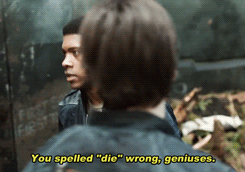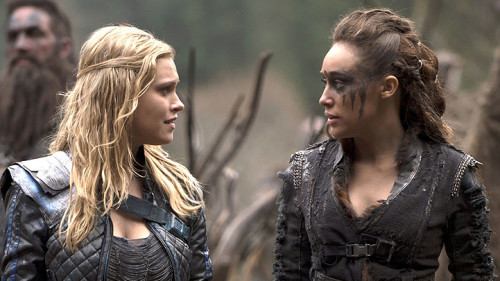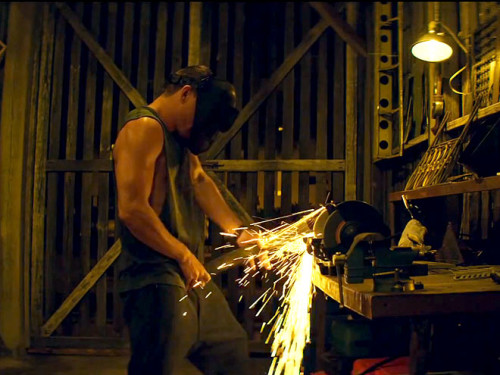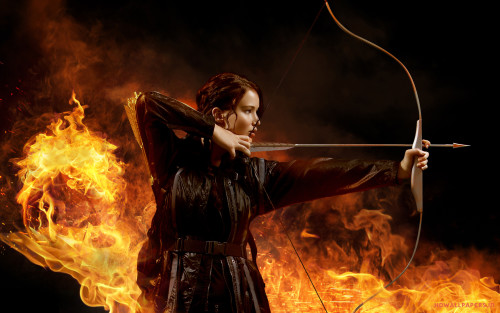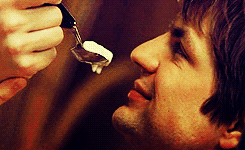This guest post by Rowan Ellis appears as part of our theme week on Violent Women.
A group of delinquent teenagers are dropped (literally) on an uninhabited hostile land and left to fend for themselves–sounds just like my GCSE English required reading Lord of the Flies, right? And, I mean spoilers, but that book doesn’t turn out great in the end; there’s fascism and death and the simulated rape of a pig, so we all know leaving teenagers on their own in survival mode doesn’t have the best track record. Sure enough, within the first 15 minutes of the first episode of the CW’s The 100, guards are pulling these teens from their cells and forcibly tagging them while there’s talk of executions, shooting them in a spaceship to Earth, and then Murphy and Wells get into a fist fight. The pilot episode of the show plays very much into what is expected- the teen boys are into violence and rebellion, the girls are giddy objects of desire or the nagging voice of reason. But then you keep watching, and the unexpected complexity of the show becomes apparent.
William Golding, author of The Lord of the Flies, talked about his time teaching at a boy’s school as an inspiration for his novel–he saw in his young pupils the capacity for being brutal little shits (I’m paraphrasing him here), and as the thin veneer of society is removed from his characters’ lives, so too are the restraints on their innate animalistic nature. The 100, however, focuses less on the propensity for evil away from society, and more on violence as a direct product of the society they’ve grown up in; when Clarke insists in Season One that Murphy be brought to justice for killing Wells, the response is “float him,” language used to describe capital punishment on The Ark. A swift and harsh system of justice on their old satellite home is arguably about survival by reducing population, but to these teens the death on the ground seems even more justified than floating people for the smallest of crimes. But the floating on the Ark, and the hanging on the ground have another crucial difference centred around physicality, violence, and distance. The literal and figurative difference in distance between pressing a button to open an airlock, versus watching someone blooded and gasping on the end of a rope you tied, versus stabbing someone with a knife, gives an ambiguity to violence and the way it is viewed on screen.
Violence on a basic level has unavoidable connotations of great physical force, fighting and hurting directly, but I would argue that this idea should be expanded out to include instances of harm and death doled out at a distance. The sacrificial death of the 300 citizens on the Ark might not have been in combat, but it is a vital act of violence by the Council, which further continued The 100’s breakdown of good vs bad characterisations on the show. In turn, the finale of Season Two sees Clarke’s own desperate act of violence, in a direct mirroring of her mother’s decision the previous season, to kill off a population for the good of “her people.” The show has an impressive amount of women in leadership roles, and much of its exploration of violence is around the lengths they will go to ensure the survival of their individual communities. In the world of The 100, which seems to be implicitly a world which has moved beyond modern sexism, this is removed from gender… but as viewers now, in a world which very much still has issues with gender inequality, these make for complex women with strong and uncompromising characterisation. They are allowed to make decisions which affect the plot as well as their own emotional state and relationships.
The violence of women in The 100 is different from most female violence on screen in that it is not itself sexualised or derived from the sexual. There are no skintight leather outfits (as seen in movies like Sucker Punch), no sexual violence (every rape revenge film ever…also Sucker Punch), no girls fighting over a boy. On the contrary, Octavia moves away from the explicit sexuality of her role in the pilot, and although her initial training is linked to Lincoln, she gravitates toward a warrior’s life to gain the respect of Indra. Although some critics have seen this as a drastic change in her characterisation, looking back at her first scene in the pilot, where she is held back by Bellamy while trying to attack the others for repeating rumours about her, it feels more like a development. Her willingness to fight is not solely centred around a Father figure or the excuse of “oh, I have three brothers” to answer the question of where this unladylike behaviour stems from, as seen in films like Hanna and Kick-Ass, but instead comes from her own anger. This individualistic anger at her history with the oppressive authority of The Ark manifests itself in a breakdown of social loyalties to her Sky People and a willingness to attach her communal identity to the Grounders.
Octavia’s identity is somewhat extraordinary, because of the immediate violence that ensues when different cultures and societies typically cross paths; from Jasper’s spearing at the end of the pilot, to the use of Grounder blood to sustain the lives on Mount Weather, the very act of creating a cohesive society seems to rely on the demonising and destruction of all others. In Lord of the Flies, the human deaths begin after the group splits themselves up into “tribes,” creating an artificial but all too real divide. Similarly, in The 100, after it is revealed that Wells was not killed by Grounders, Bellamy insists that they lie to the others, to give them a common enemy. Although at this point we are still looking to Clarke as the earnest moral compass (“The people have a right to know”), it quickly becomes obvious that this cookie cutter idea of fairness is a naivety that they can’t afford, when she inadvertently starts a murderous mob. When she boldly proclaims, “We don’t decide who lives and dies,” as if it’s her manifesto, we as an audience imagine that this is the best path forward and cheer her breaking away from the oppressive regime of The Ark. But the writers refuse such an easy way out and deny her the ability to shy away from making the harsh decisions needed in a leadership role as the world they inhabit becomes increasingly hostile. Clarke starts as a supporter of absolute morality, viewing violence as a destructive chaotic force, but her voice of reason quickly breaks down as her superior sense of morality is revealed to do more harm than good. Clarke’s first act as leader is to banish Murphy from their camp, marking him as other, essentially sentencing him to a de facto death, and ultimately becoming the start of her journey into a grey moral leadership that seems unavoidable in the world of the show.
While the visceral and hypnotic nature of the hunting and killing in Lord of the Flies is graphically horrifying in its violence, the reality of the “distanced death” in The 100 is equally disturbing. In the Season 2 finale, Clarke forces herself to watch through security footage as her actions kill every inhabitant of Mount Weather, and through tear-streaked eyes keeps watching the scene as she says “let’s go get our people.” For her, as with so many other acts of violence in both the real and fictional world, it was a terrible decision but for the “right reasons,” because it was to protect her people, her family, her loved ones. However, the edge of bitterness that permeates Eliza Taylor’s delivery of that line suggests a growing understanding in Clarke of the arbitrary nature of these divides, particularly with the cross-population romances, Octavia’s acceptance into Grounder culture, the rift between The 100 and the Ark adults, and her own relationship with Lexa. As she walks through the room of corpses and hears Jasper’s voice crack as he asks her “what did you do […] if you’d have just given me one more minute,” you can see the mirroring of the Ark culling from the previous season, and the toll it is going to take on her. One major criticism of Golding’s novel is the “cop-out” ending where the boys are rescued from the island just as the story reaches its bloody climax, but Season 3 of The 100, at least for Clarke, looks to be ultimately concerned with aftermath. The psychological backlash that Clarke experiences after her role in the massacre will undoubtedly shape her story arc next season as she journeys off alone.
Rowan Ellis is a British geek using her YouTube videos to critique films, TV, and books from a queer and feminist lens.
